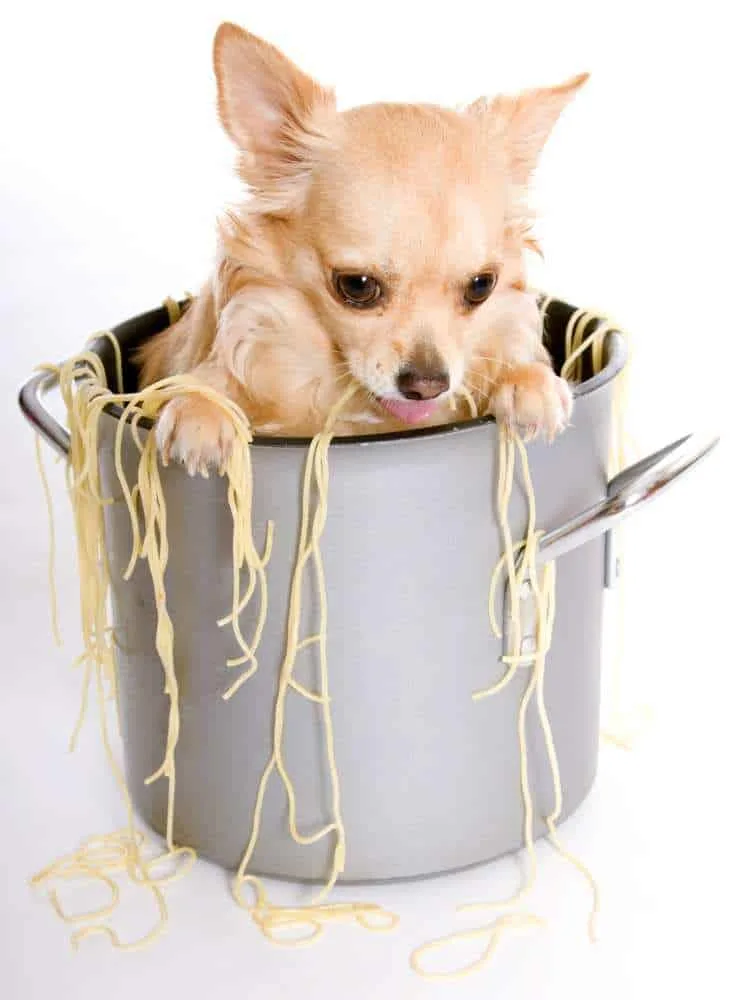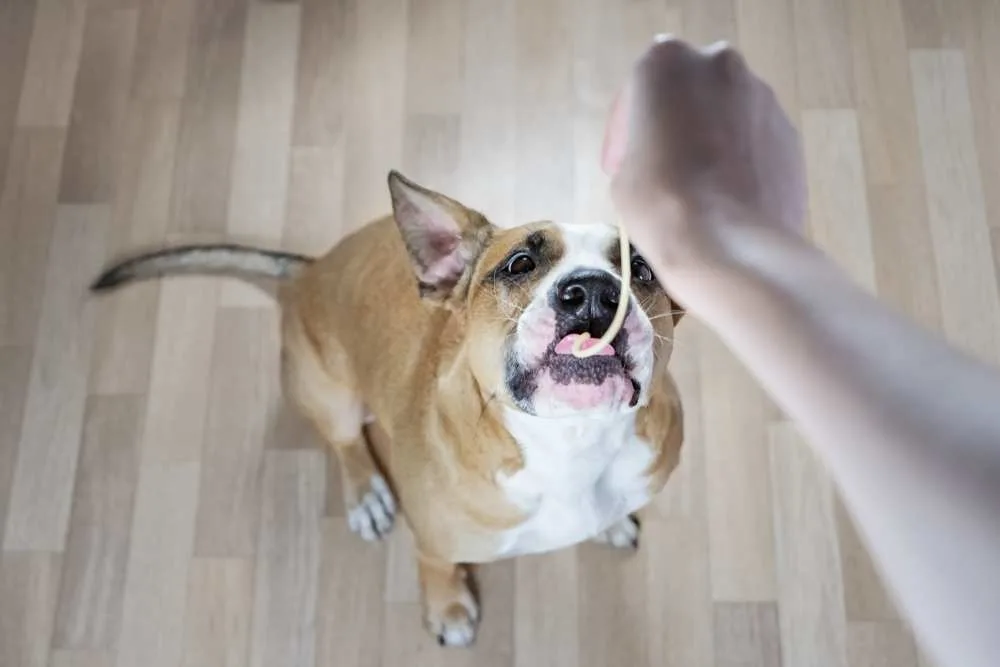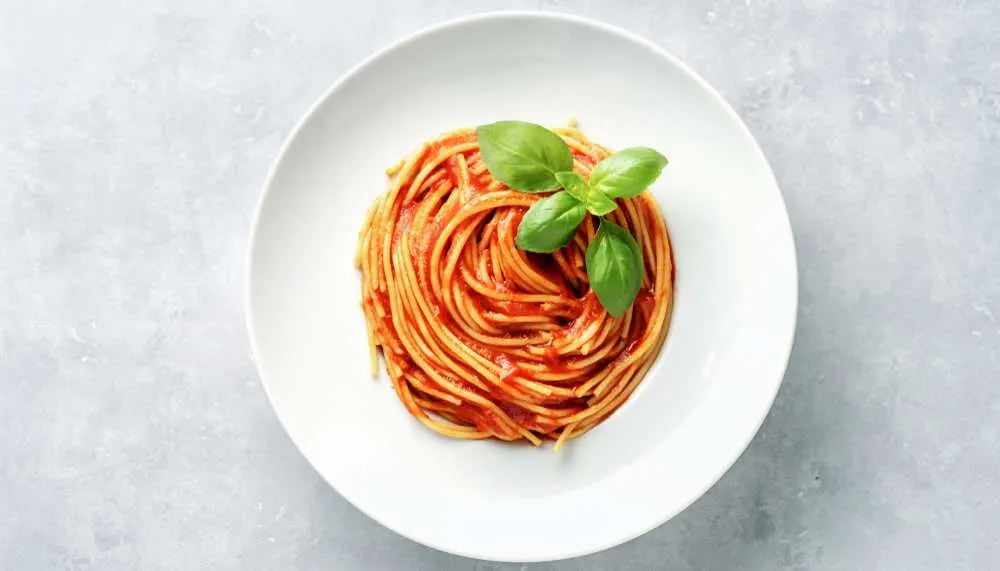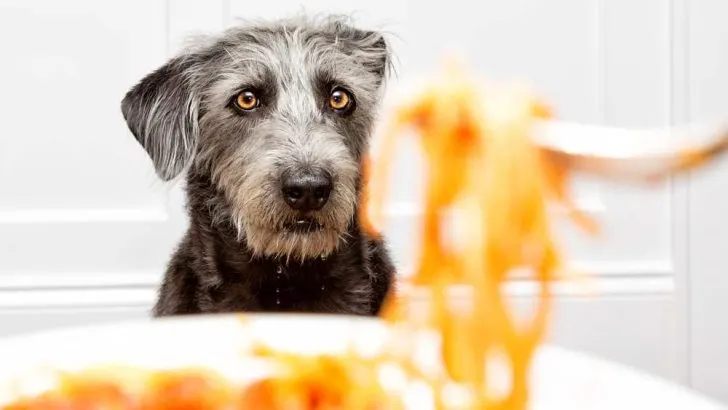You found out you’re 3% Italian, and suddenly every other meal you make has to have an Italian vibe to it.
So before you know it, you bought a tone of spaghetti and don’t know what to do with it.
Cooking spaghetti and meatballs can only take you so far before you get bored eating them every other day.
As usual, the cutest trash can ever has to step in, so you start wondering, can dogs eat spaghetti?
Since you don’t want to hurt your dog, we’re here to answer that question.

Can Dogs Eat Spaghetti?
Dogs can eat spaghetti, but maybe not in the way you think. We understand that wasting food is a big problem but tossing everything you couldn’t eat on the floor to your dog could be dangerous.
To dive a little deeper into this, we have to see why even though dogs can eat spaghetti, you might want to skip adding them to your pup’s diet.
Spaghetti Facts
Spaghetti is basically flour and water, and maybe eggs to get that extra protein. They were invented to be affordable and for a good reason. Lower classes in Italy weren’t exactly spoiled for choice, and the cheaper the food was to make the better.
That being said, none of the ingredients in cooked, uncooked, or raw pasta/spaghetti are toxic to dogs. However, it doesn’t mean they’re a good choice for your dog; let’s see why:
Nutritional Chart
| Calories | 221 |
| Fat | 1.3g |
| Sodium | 1mg |
| Carbohydrates | 43.2g |
| Fiber | 2.5g |
| Sugars | 0.8g |
| Protein | 8.1g |
Nothing to write home about, that’s for sure. But, let’s be honest, who eats spaghetti without adding anything to them.
You’ll either drown them in some type of tomato sauce or mix some delicious meat in; that’s what makes them taste so good.
Dogs, on the other hand, won’t enjoy those toppings/additions for numerous reasons.
Saucy
As we said, spaghetti without sauce is like pie without filling; it just doesn’t taste nearly as good. The thing that most sauces have in common is they contain garlic, onions, sodium (also known as table salt), and sugar.
Garlic and onions are highly toxic to dogs and can cause anemia. Pure tomato sauce, on the other hand, shouldn’t be a problem. (Dogs and tomatoes do get along; read Can dogs eat tomatoes? to find out more.)
Besides onions and garlic, there’s sodium. You don’t want your dog eating an excess of salt. Too much of it can lead to vomiting, diarrhea, seizures, high temperature, etc.
It’s a similar story with sugar. It’s just as bad for dogs as it is for us; it can cause obesity, and for dogs, that tends to be a big problem. Dogs shed weight much harder than us; once you see your dog getting fatter, lay off from the extra ‘treats.’
Probably most, if not all, store-bought sauces have both salt and sugar. So avoid feeding these to your dog at all costs.
Meaty
The famous spaghetti and meatballs are a staple of every traditional Italian kitchen. What they are not a staple of is every dog’s diet, and for a good reason.
Unless you’re taking the time to make your own meatballs, the ones you bought are probably full of spices. Dogs should stay away from spicy food as it can cause some pretty heavy health issues. (More on that in this article, Can dogs eat spicy food?)
But the story is similar to the one with the sauce. Meatballs are not just meat, but a bunch of ingredients mixed that tend to cause gastrointestinal problems for dogs.
So unless you’re willing to get your hands greasy and make a few meatballs yourself, forget about giving any to your pup.
Energy
The main purpose of carbohydrates is to provide energy. Amino acids that are found in protein can be converted to energy during exercise and, in a way, replace the need for carbs.
However, fat and carbohydrates are the preferred sources of energy for dog muscles. So dogs do need a certain amount of carbohydrates to function properly.
But spaghetti shouldn’t be your choice. They get enough carbs from the regular dog food they eat. Similar to sugar, carbs can make your dog obese, and as we said, that can weigh heavily on him. (pun intended)
Unless your dog is running the track, too many carbs are just unnecessary.

How To Serve Spaghetti?
So, after all the warnings, you’ve still decided to feed your dog some spaghetti.
There’s a way to make this as safe as possible:
1. Only A Cupful
The first thing to keep in mind is the size of the portion. Don’t overdo it; just a small cup of spaghetti is more than enough.
Spaghetti shouldn’t be on your dog’s regular diet, and this should serve more like an experiment.
We wouldn’t particularly recommend you serve raw, uncooked pasta to your dog. Nothing bad should happen, but they might not be that thrilled with it.
2. Safe Zone
Might sound like we’re beating a dead horse here, but don’t add any dangerous ingredients. It’s okay if you want to add some homemade tomato sauce, but don’t add anything extra.
If you really want your dog to have some meat with the spaghetti, make sure it’s not seasoned and is properly cooked.
Although there are proponents of a raw, uncooked meat diet for dogs, we don’t feel like recommending that just yet.
3. The Day After
When giving some new food to your dog, especially if it’s human food, definitely see how they behave after a few hours.
If your dog is showing any signs of discomfort, spaghetti might not be for him.
If the discomfort continues for more than a day, maybe go to a vet; perhaps it ate something it wasn’t supposed to with the spaghetti.

Conclusion
It’s pretty common for people to give leftovers to their dogs. Most of the time, nothing bad happens, and the pups are happy their owners made an effort to feed them.
However, due to the high availability of regular dog food and how relatively cheap it is, maybe avoid giving your pet human food. We’ve said several times in this article that store-bought items tend to have just too many additives.
Yes, dogs can eat spaghetti, but honestly, who actually eats just spaghetti without any toppings?
Not a lot of people. If, however, you decide to give it spaghetti, make sure to keep a few things in mind.
Don’t overdo it; it shouldn’t happen on a daily basis. Letting them have a cup every now and then should be fine, but any more than that, and they might start getting fat.
Watch how you serve it. Avoid store-bought sauces and seasoned meat. Garlic, onions, sugar, and too much salt all pose a pretty big danger to canines.
But, with all honesty, stick to regular dog food.
Sometimes it’s better to keep it simple than risk hurting such a lovely creature.
Learn More: What Can Dogs Eat? A Comprehensive List Of Dog-safe Foods

